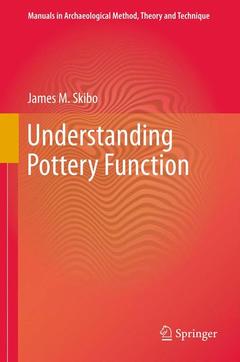Description
Understanding Pottery Function, 2013
Manuals in Archaeological Method, Theory and Technique Series
Language: English
Understanding Pottery Function
Publication date: 10-2013
192 p. · 15.5x23.5 cm · Paperback
Publication date: 10-2013
192 p. · 15.5x23.5 cm · Paperback
Understanding pottery function
Publication date: 08-2012
192 p. · 15.5x23.5 cm · Paperback
Publication date: 08-2012
192 p. · 15.5x23.5 cm · Paperback
Description
/li>Contents
/li>Biography
/li>Comment
/li>
The 1992 publication of Pottery Function brought together the ethnographic study of the Kalinga and developed a method and theory for how pottery was actually used. Since then, there have been considerable advances in understanding how pottery was actually used, particularly in the area of residue analysis, abrasion, and sooting/carbonization. At the 20th anniversary of the book, it is time to assess what has been done and learned. One of the concerns of those working in pottery analysis is that they are unsure how to ?do? use-alteration analysis on their collection. Another common concern is understanding intended pottery function?the connections between technical choices and function. This book is designed to answer these questions using case studies from the author and his colleagues for applying use-alteration analysis to infer actual pottery function. The focus of Understanding Pottery Function is on how practicing archaeologists can infer function from their ceramic collection.
1. Understanding Pottery Function.- 2. Intended Function: Inferring Manufacturing Performance.- 3. Sooting and Carbonization.- 4. Attrition.- 5. Residue.
James M. Skibo is a Distinguished Professor of Anthropology at Illinois State University and the 2012 recipient of the Society for American Archaeology’s Award for Excellence in Ceramic Analysis. Besides his ethnoarchaeological work in the Philippines he has conducted research in the American Southwest and he currently works in the Great Lakes and directs the Grand Island Archaeological Project.
Builds on the research presented in Pottery Function, a 1992 publication by the same author Includes numerous case studies by the author Manual includes numerous illustrations to facilitate pottery analysis Includes supplementary material: sn.pub/extras
© 2024 LAVOISIER S.A.S.





